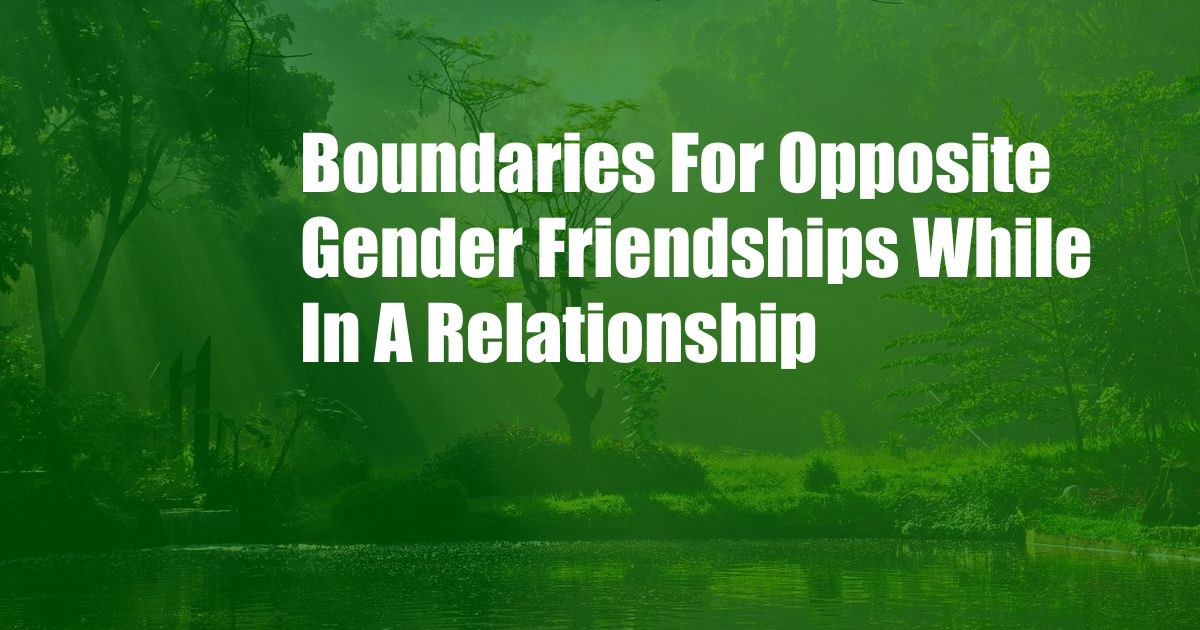
Healthy Boundaries in Opposite-Gender Friendships: Navigating Relationships with Respect
As we journey through life, we encounter individuals of diverse backgrounds and genders, forming connections that enrich our experiences. While these friendships can be fulfilling, it’s crucial to establish clear boundaries to maintain respect and preserve the integrity of our romantic relationships.
The Spectrum of Boundaries
Defining boundaries involves setting limits to protect our physical, emotional, and intellectual spaces. In opposite-gender friendships, these boundaries become particularly important as they help prevent misunderstandings and potential conflicts within the romantic partnership. Boundaries can range from physical distance, such as limiting one-on-one meetings, to emotional boundaries like avoiding sharing intimate details or engaging in flirty conversations.
Preserving Intimacy in Relationships
Intimacy is a cornerstone of any romantic relationship. By establishing boundaries in opposite-gender friendships, we safeguard the emotional exclusivity and trust within our primary relationship. Clear limits communicate to our partners that they are our priority and minimize potential feelings of insecurity or jealousy. Moreover, boundaries help maintain a healthy balance between our social and romantic lives, ensuring that neither aspect overshadows the other.
Communicating Boundaries Effectively
Open communication is paramount in setting and maintaining boundaries. Engage in a respectful and non-confrontational dialogue with both your partner and the friend. Clearly articulate your needs and expectations, being specific and direct. Explain your reasons for establishing these boundaries, emphasizing the importance of their adherence to maintain the integrity and health of your romantic relationship.
Navigating Gray Areas
Navigating opposite-gender friendships can sometimes involve navigating uncertain territories or gray areas. In such situations, it’s crucial to exercise discretion and sensitivity. Consider your partner’s perspective and be mindful of any potential discomfort they may experience. Seek guidance from trusted individuals, such as a close friend or therapist, if needed, to gain an objective perspective and make informed decisions.
Embracing Growth and Evolution
Recognizing that boundaries are not static but may evolve and adapt over time is important. As you grow and change, your boundaries may need to be revisited and renegotiated. Have regular check-ins with both your partner and the friend to ensure that the boundaries are still serving their intended purpose and contributing to the health of your relationships.
Tips and Expert Advice for Healthy Boundaries
- Establish clear boundaries from the outset: Communicate your limits directly and honestly to avoid misunderstandings later on.
- Respect the boundaries of your partner: Be mindful of their comfort levels and avoid crossing their boundaries.
- Prioritize your romantic relationship: Choose to spend quality time with your partner over friends of the opposite gender when possible.
- Seek support from trusted individuals: Confide in a close friend, therapist, or trusted family member to gain support and guidance.
- Trust your instincts: If you feel uncomfortable with any situation, it’s best to trust your intuition and remove yourself from it.
Frequently Asked Questions (FAQs)
-
Q: How can I tell if my opposite-gender friend is crossing boundaries?
A: Pay attention to red flags such as inappropriate physical contact, excessive texting or calling, and attempts to undermine your romantic relationship. -
Q: Is it okay to have opposite-gender friends when I’m in a relationship?
A: Yes, it’s possible to have healthy opposite-gender friendships while in a relationship, as long as boundaries are established and respected. -
Q: How should I respond if my partner expresses discomfort with my opposite-gender friendships?
A: Listen attentively to their concerns, validate their feelings, and work together to find a solution that respects both their needs and your own.
Conclusion
Navigating opposite-gender friendships with clear boundaries is essential for maintaining healthy and fulfilling romantic relationships. By prioritizing our partners, communicating our needs effectively, and embracing growth and evolution, we can create a supportive and mutually respectful environment where all parties feel valued and secure.
Call to Action:
Are you struggling to establish healthy boundaries in your opposite-gender friendships? Share your experiences and seek support in the comments section below. Let’s work together to build stronger and more fulfilling relationships.